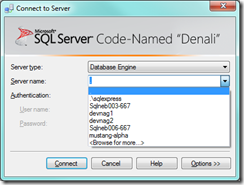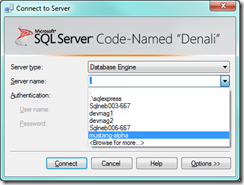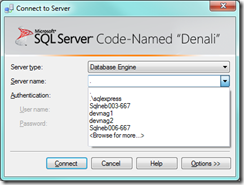Deleting Old server names from "Connect to Server" dialog in SSMS
In an earlier Denali CTP, we had introduced a mechanism for customers to delete the un-used/not required server names from the drop down in connection box in SSMS. There has been a big customer ask for helping them remove the redundant server names from the MRU list.
Here is a blog post from Devesh Nagpal, a developer in the SQL Server Manageability Team describing this new feature in SQL Server Code Named “Denali” CTP3.
--
There are a few undocumented ways on doing this as mentioned here,
The problem with using undocumented feature were
1) There were side effects of doing it like losing SSMS specific Tools | Options settings, OE Details List View Customizations, the MRU list for OE Details Search, and MRU for Reports.
2) There was no official support from Microsoft.
We will now be supporting Deleting the server name from MRU list officially. This will help customers remove any Server name from the drop down list they do not wish to see. With regard to addition of servers to this list, there is no change to the earlier behavior – the server name will get appended to the list once you connect to it.
Here is a simple demonstration of how you can now easily remove the Server names from MRU list from CTP2 Denali.
As shown in the picture below there might be multiple machines you have connected to in SSMS. All will be shown in history sorted by when you have last used them.
To delete the dead servers from the list, select the name you want to delete either via mouse or via keyboard. As shown in the image below.
Now press the delete key on the keyboard, the item will be deleted from the list.You can delete as many items as you want. Note that the text in the box will remain to your last selection even after delete.
Current Limitations
1) No multiple select and delete, the delete has to be one by one for server names. There is no multiple select and delete option.
2) You will have to rely on keyboard for actually deleting the item, right click on item and then deleting it is not supported.
3) There is no global list to keep track of the server names users have deleted and not to add them in the list again. The list will be re-populated once the user connects to a new server name (which is not present in the list).
Devesh Nagpal can be reached at devnag@microsoft.com.
Comments
Anonymous
July 12, 2011
What would be really great is if we could have access to the list. The issue many users have is they have duplicate entries, not simply too many. It's not necessarily true that any of the servers in the list are dead, but one may be Windows auth, one may be sa, one may be a peon SQL auth user, etc. I'm thankful for the usability enhancement but I think it could be so much more powerful if we could really tell which entry was which.Anonymous
October 19, 2011
I just tried this using SSMS 10.0.1064.0 and it didn't work.Anonymous
January 11, 2012
delete the file in the following location C:Documents and Settings<user>Application DataMicrosoftMicrosoft SQL Server90ToolsShellSEMmur.datAnonymous
April 27, 2012
This does not work on SS2008R2 RTM. Not being able to clear selected items from this list is a serious annoyance! Wake up Microsoft. This is something that affects EVERY user of SSMS! Why would you want to annoy the vast majority of your SSMS users?Anonymous
August 31, 2012
It should also work for logins dropdown (e.g. 3 logins for same server and I need to delete 2 of them)Anonymous
December 12, 2012
Still doesn't work (Microsoft SQL Server Management Studio 11.0.3000.0 here).Anonymous
April 10, 2013
It works with Microsoft SQL Server Management Studio 11.0.3128.0. Thank you.Anonymous
July 22, 2013
Quasi worked on SSMS 10.0.5512.0 (2008), it ended up deleting ALL the entries in the drop down list.Anonymous
December 04, 2013
This does not work in Microsoft SQL Server Management Studio 11.0.2100.60Anonymous
January 19, 2014
The comment has been removedAnonymous
February 25, 2014
Thanks! it works on SSMS 2012 v 11.0.2100.60Anonymous
October 07, 2015
It worked for me in SQL Server Management Studio 2012.Anonymous
December 03, 2015
Please help. I have an application that connects to a SQL Server db via a DSNLESS connection string using the ODBC driver. I have implemented it at several sites already without any problem. I'm currently deploying it to another new site. However, the app is failing to connect first time but it's bringing up a MS SQL login screen where it displays the server, user id and password fields populated with the correct connection details. If I click OK on this screen without changing anything it then connects. On checking on the server drop list I saw that there are 2 instance names which are exactly the same. They both look like SERVERSERVERSTORE. I confirmed this by setting up an SQL Server odbc data source on the same server which is installed with MS SQL Server 2012. I went into MS Studio Management and deleted one instance but it still comes up as discussed up. I want to know how to delete 1 of the instances so it doesn;t come up and interfere with my application.Anonymous
February 01, 2016
it worked perfectly well in Microsoft sql server 2012!Anonymous
March 03, 2016
Really? Because that does not happen at all Those who are saying it does work are clearly deluded and have not correctly tested


